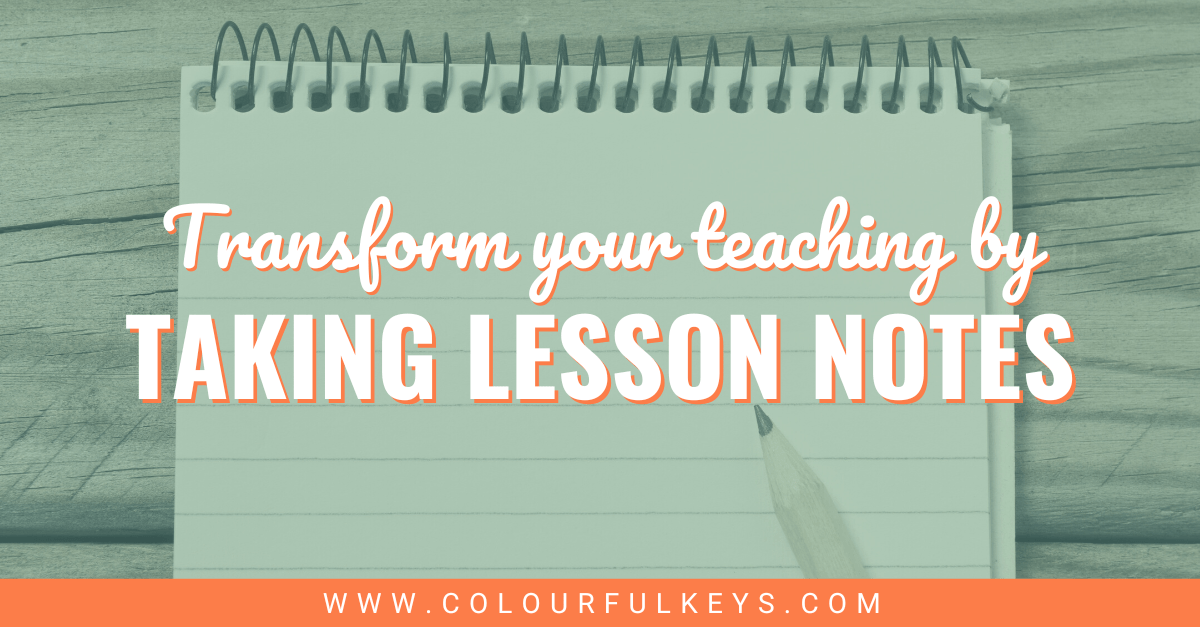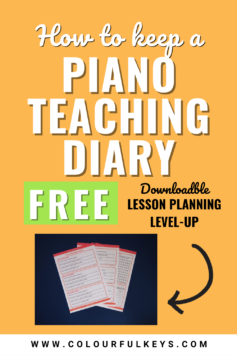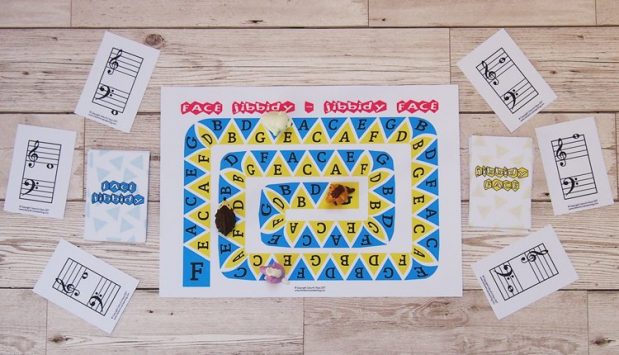
This blog post about taking notes in piano lessons was written by Ruth McAdoo. Ruth has a degree in Theology/Vocal Performance from Appalachian Bible College and has been teaching creative piano, violin, voice and ukulele students near St. Louis, Missouri USA for the last 5 years. When she’s not teaching, you can find Ruth listening to film scores, mixing up a fresh batch of waffles or rollerblading into the sunset with her husband, Micah.
Have you ever stepped back as a teacher and observed yourself? If you have, you know it can be a painful process – yet such a helpful one.

A year ago, I started journalling after every lesson. What started out as simply a tool for tracking progress and planning lessons soon became an invaluable resource for improving my teaching.
The results have been transformational – not just for myself, but for my students. Now, each week, I have a 360º view of exactly where every student is in their learning, which makes lesson planning a breeze.
And, for the first time, I’m seeing students make incredible progress and reaching their goals faster.
Tracking Student Progress
If you’re a human with a brain (like me! 😆) you may also deal with the eternal struggle of remembering things.
The Memory Dilemma
Music studio teachers like us need to remember things that pertain to 10, 20, 30 or 40 people besides yourself.
I was getting overwhelmed by the task of remembering the work I’d set for everyone. I’d always sent home handwritten assignments for my students, but I knew I wasn’t doing as well as I could as far as keeping track of what happened within each lesson.
A “Note-Worthy” Solution
To combat this lack of organisation, I set myself a challenge:
Keep track of what goes on in every lesson for an entire term. (Where I live, that’s roughly 18 weeks.)
I started by making myself a simple tracking sheet using Google Docs, with the student’s name and the year/term at the top. Below that I added a grid of boxes I could write in, with one row representing each weekly lesson.
I can almost see the shocked look on some of your faces…
A whole semester?
On one page?
But that means…
A whole lesson?
In one 4 cm by 8 cm box?

I intentionally wanted my space to be small, so I decided to switch from digital to analogue. I knew whatever I started had to be realistic for me and viewable at a glance, so I limited my space. This isn’t a Dickens-length novel, after all!
Tech can be great, but I find that typing can distract me and my students more if I’m taking notes during the lesson.
I recommend experimenting with both analogue and digital formats to see which works best for you.
If you’re looking for a ready-made digital progress tracker, VMT members can instantly copy Nicola’s Weekly Student Progress Notes Google Doc. Not a member? Learn more and sign up today on the membership home page.
My Note-Taking System
Things I kept track of:
- The songs/sections of songs we worked on
- New theory concepts we covered
- What games we played (and their scores)
Once I got comfortable jotting down those little notes, I started writing in next week’s box:
- Any songs we didn’t get to today that I wanted to check on next week
- What concept is coming up soon to introduce through improv next week
- Games that would be a good fit, based on what concepts would need reviewing from this week
Does that sound a bit like… lesson planning to you?
I didn’t have any sort of consistent system for lesson planning before I implemented this – just loads of post-it notes everywhere. This was a small, non-overwhelming way to start the important habit of thinking ahead for the benefit of my students!
Spoiler: It helped me so much that I continued for a full year after the beginning of my challenge, and I have no plans of stopping anytime soon.
The Results
I’d love to tell you that I wrote notes in every row, every week.

But I’ll be 100% honest:
- I didn’t always take notes on days I felt tired – I saved my limited energy for engaging with my students.
- Towards the end of my week, I didn’t always take notes (an uncomfortable student inequality which I subsequently had to face up to!)
- For younger students, I often took notes sometime after their lesson (instead of during) as I found those students needed more direct attention
Those disclaimers aside, I took notes more than I didn’t take notes, and I discovered some incredible benefits from it.
Lessons I Learnt From Taking Notes
Although I wasn’t perfect, I learnt key lessons from this note-taking style. Before you read ahead, know that these are my results.
These are flaws and areas which needed growth in my own teaching.
Even if you can’t relate to my experiences, my hope is that it will help you reflect more on your own teaching as I’m learning how to do.
Gaining Clarity and Focus
I’m sure you never get distracted….right? 😉
I frequently find my mind wandering, especially if a student is playing a piece I’ve heard fifty times before.
I start to slowly zone out, only to snap back once they’ve finished with a, “Very good, and next…” kind of response. Just being painfully honest here!
Taking brief notes while students are playing has helped me pay attention better.
And because I, as the teacher, set the tone in the room, keeping myself better engaged helps my students stay better engaged.
In fact, with my older students, my notetaking is less of me writing down what needs work and more of us discussing what went well and what they’d like to work on in the next lesson.
Better Rapport With Students
I’m sure if you tell a student you’re going to do something (listen to a song they mentioned or print a certain piece) you always do it….right?
I tend to align more with the absent-minded professor stereotype than I would care to admit. Yikes!

Younger students don’t always pick up on what you’ve forgotten from week to week, but teens do. They’re always watching and listening for any excuses as to why I didn’t look for arrangements for the pop song they want to play at the next recital.
Definitely not the example I want to set for them!
I’ve noticed a huge improvement in the quality of my teen lessons since I started taking notes in lessons.
- They see me writing down their suggestions, and following through with my promises
- My teens become part of the lesson-planning process, as we discuss and write down goals for our next lesson
- I’m able to share concrete wins with them from our notes (“You sang a whole step higher today than in our range exercise last week!”, or, “We’ve only been working on this piece for 3 weeks, and you already have the first 16 bars memorised!”)
When I take my teens’ lessons more seriously, they take their lessons more seriously.
Is it time to move on?
I often find myself in the tricky-piece time warp, a dubious black hole where the hope of ever finishing a slightly-too-difficult piece goes to die.
Does that sound familiar to you?
Having several pieces of information in front of me helps me and my students, answer the following questions, freeing us from the clutches of the tricky-piece time warp:
- How long have we been working on this piece?
- What were the initial challenges, and have we made trackable progress?
- What have we learnt from this piece?
- Is this a performance piece which must be perfected, or is it time to celebrate the progress made and skills developed and move on?
Less, and More, Repetition
Before my new note-taking process, I often found myself giving the same ol’ correction speeches.
“You know how a bag of potato chips looks a certain size, but you open it up and it’s mostly air? Well, that note on the page looks like it should be a half-note, but I only heard it playing for one beat.”
(Go ahead and roll your eyes at my bad analogy, and please comment with better ones. 🙄)
If a student is consistently struggling with a particular aspect of music, I need to be consistently helping them.
But not always by repeating the same thing over and over.
Are they having trouble with bass-clef note names?
We played FACE-Jibbidy last week; maybe we can hit that concept again this week by doing some flashcard drills, shading all the bass clef lines in our book with a blue crayon, or experimenting with the floor staff.
I can only incorporate those different activities well if I remember what we’ve already done and proactively address what I know they need help with.
Disclaimer: I do want to repeat games and activities. Repetition is a key part of the learning process. What I don’t want to do is to repeat activities which aren’t helping. I want to approach the concept in several ways so it “clicks” with the student.
When a student walks in now, I look at their chart and remember we need to work on quavers (eighth notes) first…but I can see how we did that last week and if it worked well, or if it’s time to try a new strategy.
Would I recommend keeping notes of your lessons?
Yes.
Yes, yes, yes!
(If you’re not sure about my position on this, let me clarify…it’s “yes”!)
I’ve heard Nicola say if you want to get better at something, video record yourself and watch it back.
Note taking was like a less-involved, longer version of that process for me.
There are so many areas I want to improve as a teacher, including:
- Becoming more engaging
- Pacing and staggering material
- Effectively choosing games and activities
- Listening – really listening – to my students
For me, one of the most important steps to growth is not only professional development courses but also self-reflection to identify patterns in my teaching.
If you’re not sure what areas you could use some work in, why not take the Teacher Tracker quiz?

How do you keep track of students’ progress in your piano studio?
Do you have a note-taking method of your own? If not, does this sound like a good solution for you? Let me know in the comments below.
If you need help getting going on a consistent lesson planning process, enter your info below and Nicola will send the Lesson Planning Level-Up resource right to your inbox. Then hop over to her Planning Lessons hub page for the latest-and-greatest tips, tricks and tools.

Subscribe to the newsletter and get the Lesson Planning Level-Up
Enter your details to subscribe to the newsletter for piano teachers with information, tips and offers.
I hate spam as much as you do! I will only send you emails related directly to piano teaching and you can unsubscribe at any time.

Great article! I loved Ruth’s honest assessment of her own teaching and her resulting suggestions. Good stuff!! Thank you!
I take notes, but usually only about what I want to do during the lesson and whether we managed to do it or if it needs to be moved to next week, as well as any follow-up to-dos for me. After reading this I think I will incorporate a bit of reflection/ assessment too. I do mine bullet-journal style which I find a really useful shorthand and should work to add the reflection bit, so I’m excited to try that. My main problem with adding more writing time is that I already have a lot of writing time in lessons because I have a lot of very young students, so I write a weekly “what we did today” as well as “homework for next time” section in their notebooks for parents. But I’ll see how I can fit it in!